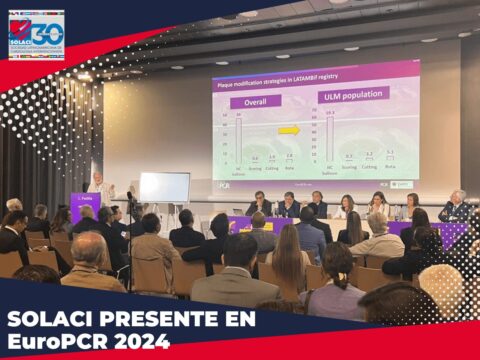Original title: Fractional Flow Reserve–Guided PCI for Stable Coronary Artery Disease. The FAME 2 Trial Investigators. Reference: Bernard De Bruyne et al. N Engl J Med 2014;371:1208-17.
The FAME 2 and the COURAGE studies tested similar hypothesis, only in the first study PCI was guided by fractional flow reserve (FFR) in addition to an angiography. The study hypothesis was that FFR guided PCI would be superior to the optimal medical treatment (OMP).
1220 patients with stable coronary artery disease were evaluated and FFR was measured in all lesions visible by angiography. Patients presenting at least one ≤ 0.8 FFR lesion were randomized to PCI and OPM vs. OPM alone. Patients with > 0.8 FFR lesions received PMT and were included in a registry.
Primary end point was a composite of all cause death, nonfatal infarction and emergency revascularization within 2 years, emergency revascularization regarded as such in the context of hospitalization due to angina, regardless of changes in ECG or enzyme elevation.
Primary end point was significantly lower in the PCI group compared to the OMP group (8.1% vs. 19.5%; HR 0.39; CI 95% 0.26 to 0.57; p<0.001). This difference was basically due to a lower rate of emergency revascularization in the PCI group (4.0% vs. 16.3%; HR 0.23; IC 95% 0.14 to 0.38; p<0.001) since global death and infarction rates were similar in both groups.
From day 8 after PCI until two years later, death and AMI rates were lower in the PCI group (4.6% vs. 8.0%, p= 0.04). Patients with no significant FFR included in the registry presented a 9% primary end point rate at 2 years.
Conclusion
In patients with stable coronary heart disease, FFR guided PCI showed better results than OMT. Patients with no signs of ischemia by FFR had a good evolution with OMT.
Editorial Comment
The decision to interrupt the study and anticipate collected data given the excess of emergency PCI procedures in this line of treatment was quite criticized and hindered the observation of hard end points. The fact that patients were aware of their coronary anatomy could have lower the FFR ≤0.8 revascularization threshold in this line of treatment.
Considering infarction after day 8 excluded peri procedural infarction, which is reasonable given that the prognostic value of a spontaneous infarction is quite different from that of a peri procedural infarction.
Another important detail is the events rate between PCI treatment and patients that made the registry, because they had no significant lesions by FFR, was very similar. This has a double implication: first, FFR assessment clearly sets lesions apart and a FFR > 0.8 lesion criteria is safe; secondly, patients with significant FFR lesions treated with second generation stents evolve as well as patients with no signs of ischemic cardiomyopathy.
SOLACI



